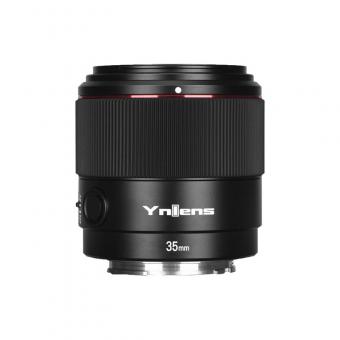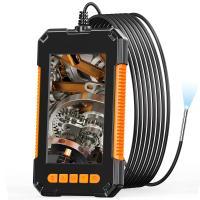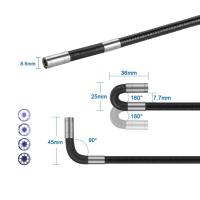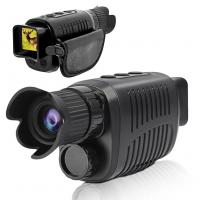What Is An Ip Camera ?
An IP camera, also known as a network camera, is a type of digital video camera that is used for surveillance and security purposes. It uses the Internet Protocol (IP) to transmit and receive data, allowing it to be connected to a network or the internet. IP cameras are typically used in both residential and commercial settings to monitor and record video footage.
Unlike traditional analog cameras, IP cameras capture and encode video in a digital format, which offers several advantages. They provide higher resolution and image quality, as well as the ability to zoom in and out without losing clarity. IP cameras can also be accessed remotely, allowing users to view live or recorded footage from anywhere with an internet connection.
IP cameras are often equipped with additional features such as motion detection, night vision, and two-way audio communication. They can be integrated with other security systems and devices, such as alarms and access control systems, to create a comprehensive surveillance solution.
1、 Definition and Function of IP Cameras
An IP camera, also known as an Internet Protocol camera, is a type of digital video camera that is used for surveillance and security purposes. Unlike traditional analog cameras, IP cameras transmit video and audio data over a computer network or the internet, allowing for remote viewing and recording.
The main function of an IP camera is to capture high-quality video footage and transmit it in a digital format. This digital data can then be accessed and viewed from anywhere with an internet connection, using a computer, smartphone, or tablet. IP cameras can be connected to a local area network (LAN) or a wide area network (WAN), making them highly versatile and flexible in terms of installation and usage.
IP cameras offer several advantages over analog cameras. They provide higher resolution and image quality, allowing for clearer and more detailed video footage. They also offer advanced features such as motion detection, night vision, and two-way audio communication. Additionally, IP cameras can be easily integrated with other security systems, such as alarms and access control systems, creating a comprehensive surveillance solution.
In recent years, there have been advancements in IP camera technology, including the use of artificial intelligence (AI) and machine learning algorithms. These technologies enable IP cameras to analyze video data in real-time, automatically detecting and alerting users to suspicious activities or events. This has greatly enhanced the effectiveness and efficiency of IP camera systems in various applications, such as retail, transportation, and smart cities.
Overall, IP cameras have revolutionized the field of surveillance and security, providing users with greater control, flexibility, and peace of mind. With continuous advancements in technology, IP cameras are expected to become even more sophisticated and intelligent in the future.

2、 Types and Features of IP Cameras
An IP camera, also known as an Internet Protocol camera, is a type of digital video camera that is used for surveillance and security purposes. It uses the Internet Protocol to transmit video and audio data over a network, allowing users to remotely monitor and control the camera from anywhere in the world.
IP cameras have become increasingly popular in recent years due to their advanced features and capabilities. They offer high-resolution video quality, allowing for clear and detailed footage. They also have the ability to pan, tilt, and zoom, providing users with a wide range of viewing angles and options.
One of the key advantages of IP cameras is their ability to be easily integrated into existing network infrastructure. They can be connected to a local area network (LAN) or a wide area network (WAN), allowing for seamless integration with other devices and systems. This makes it easier to manage and control multiple cameras from a central location.
Furthermore, IP cameras offer advanced features such as motion detection, night vision, and two-way audio. Motion detection allows the camera to automatically start recording when it detects movement, while night vision enables the camera to capture clear footage in low-light conditions. Two-way audio allows users to communicate with people near the camera, making it useful for applications such as video conferencing or remote monitoring.
In recent years, there has been a shift towards the use of IP cameras with artificial intelligence (AI) capabilities. These cameras are equipped with advanced algorithms that can analyze video footage in real-time, allowing for more accurate and efficient surveillance. AI-powered IP cameras can detect and track objects, recognize faces, and even identify suspicious behavior, enhancing the overall security and effectiveness of the camera system.
Overall, IP cameras offer a wide range of features and capabilities that make them an ideal choice for surveillance and security applications. With advancements in technology, such as AI integration, IP cameras continue to evolve and provide even more advanced functionalities for users.

3、 Benefits and Advantages of IP Cameras
Benefits and Advantages of IP Cameras
IP cameras, also known as Internet Protocol cameras, are digital video cameras that transmit and receive data over a computer network or the internet. They have become increasingly popular in recent years due to their numerous benefits and advantages over traditional analog cameras.
One of the main advantages of IP cameras is their high image quality. They capture video in high definition, allowing for clear and detailed footage. This is particularly important in surveillance applications where identifying individuals or objects is crucial. Additionally, IP cameras often have advanced features such as wide dynamic range and low-light capabilities, further enhancing the quality of the video.
Another benefit of IP cameras is their flexibility and scalability. They can be easily integrated into existing network infrastructure, eliminating the need for separate cabling systems. This makes installation and maintenance simpler and more cost-effective. Additionally, IP cameras can be easily expanded or relocated as needed, making them ideal for businesses or organizations that may need to adjust their surveillance systems over time.
IP cameras also offer remote accessibility, allowing users to view live or recorded video from anywhere with an internet connection. This is particularly useful for businesses with multiple locations or for homeowners who want to keep an eye on their property while away. Many IP cameras also offer mobile apps, making it even more convenient to monitor video on smartphones or tablets.
Furthermore, IP cameras often come with advanced analytics capabilities. These cameras can analyze video footage in real-time, detecting and alerting users to specific events or behaviors. This can include motion detection, facial recognition, or even object tracking. These analytics can help improve security and efficiency in various applications, such as retail stores, airports, or industrial facilities.
In recent years, there has been a growing trend towards the integration of IP cameras with other smart devices and systems. This includes integration with access control systems, alarm systems, and even artificial intelligence platforms. This allows for a more comprehensive and intelligent security solution, providing users with a higher level of protection and automation.
In conclusion, IP cameras offer numerous benefits and advantages over traditional analog cameras. Their high image quality, flexibility, remote accessibility, advanced analytics, and integration capabilities make them a popular choice for various surveillance applications. As technology continues to advance, we can expect further enhancements and innovations in IP camera systems, providing even more value and functionality.

4、 Installation and Setup of IP Cameras
Installation and Setup of IP Cameras
An IP camera, also known as an Internet Protocol camera, is a type of digital video camera that is used for surveillance and security purposes. Unlike traditional analog cameras, IP cameras transmit video and audio data over a network or the internet, allowing for remote viewing and monitoring.
The installation and setup of IP cameras involve several steps to ensure proper functionality and optimal performance. Firstly, it is important to choose the right camera for the specific surveillance needs. IP cameras come in various types, including dome, bullet, and PTZ (pan-tilt-zoom), each with its own advantages and features.
Once the camera is selected, the next step is to determine the optimal location for installation. Factors such as the field of view, lighting conditions, and potential obstructions need to be considered. Mounting the camera securely and ensuring proper cable management are crucial for long-term reliability.
After physical installation, the camera needs to be connected to the network. This can be done either through a wired Ethernet connection or wirelessly using Wi-Fi. Configuring the camera's network settings, such as assigning an IP address and setting up port forwarding, is necessary for remote access and viewing.
To access and manage the IP camera, software or a web-based interface is typically used. This allows users to view live video feeds, adjust camera settings, and set up motion detection or recording schedules. Many IP cameras also offer mobile apps, enabling users to monitor their surveillance system on smartphones or tablets.
In recent years, advancements in IP camera technology have led to the integration of artificial intelligence and video analytics. These features enable cameras to detect and analyze objects, people, and events in real-time, providing enhanced security and automation capabilities.
Overall, the installation and setup of IP cameras require careful planning and attention to detail. With the latest advancements in technology, IP cameras have become an essential tool for surveillance and security, offering flexibility, scalability, and remote accessibility.






























There are no comments for this blog.